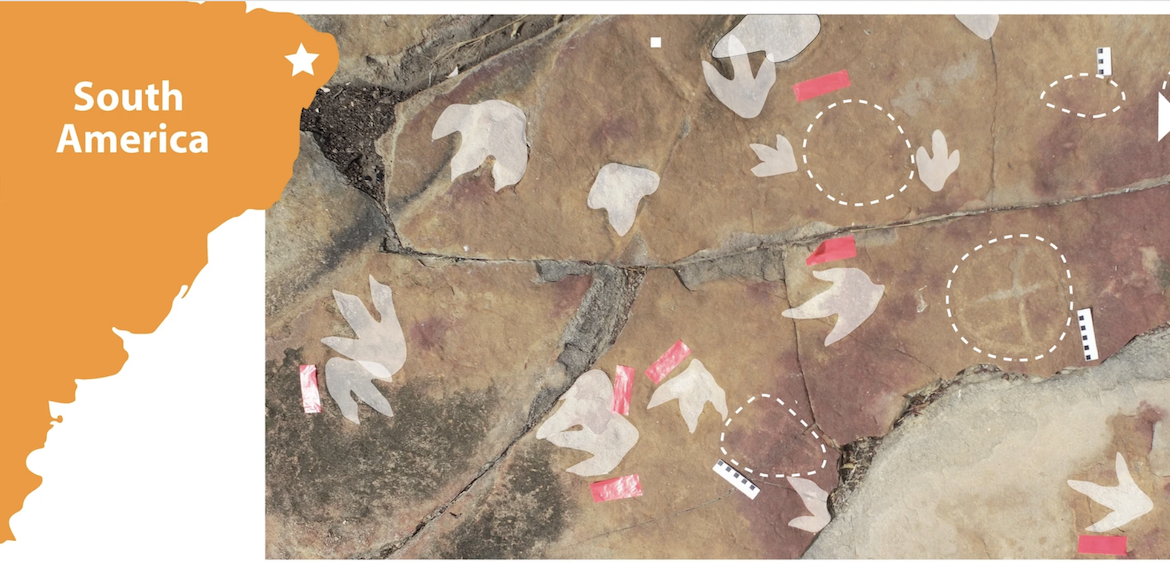
History Engraved on the Rocks
Researchers have discovered a bridge to almost prehistoric times in Brazil: on one side, dinosaur footprint fossils; right next to them, thousands-of-years-old symbols etched into stones. Located in the municipality of Sousa in the northeastern state of Paraiba, Brazil, the Serrote do Letreiro Area fascinates both paleontology and archaeology enthusiasts, merging two distinct periods.
A recent study published in Scientific Reports focuses on ancient inscriptions (petroglyphs) that appear deliberately placed around the dinosaur footprints, revealing the interest ancient indigenous communities in Brazil had in fossil traces.
Serrote do Letreiro features rocks from the Antenor-Navarro Formation, dating back to the Jurassic period, surrounded by local vegetation. To appreciate its unique features, a closer look at the stones is necessary. Here, fossilized footprints of Theropods, Sauropods, and Iguanodonts dating back approximately 66 million years to the end of the Cretaceous period can be found. What sets these fossil traces apart is their juxtaposition with ancient petroglyphs adorned mostly with circular motifs.
At the heart of this unique area, there is an extraordinary proximity between petroglyphs carved into rock outcrops and dinosaur footprints. Some petroglyphs seem intentionally placed adjacent to dinosaur prints, ensuring they do not overlap. This suggests that prehistoric humans were intrigued by fossil traces and integrated them into their graphic expressions.
The discovery of Serrote do Letreiro began with paleontologist Giuseppe Leonardi’s work in the late 1970s. While Leonardi documented both dinosaur footprints and ancient petroglyphs at Serrote do Letreiro, a comprehensive analysis of these petroglyphs had not been conducted until recently, nor had the relationship between fossil traces and rock carvings been thoroughly explored.
The newly revealed petroglyphs consist mostly of circular motifs and other geometric patterns. They were etched into the rock surface with abrasive tools and later refined using pecking techniques, enhancing their depth and durability, though some carvings have suffered erosion over time.
While the exact time of these drawings remains uncertain, radiocarbon dating from nearby settlements suggests that the people who left these artworks may have lived between 9,400 and 2,620 years ago. The drawings exhibit different styles, likely indicating multiple artists.”
Leonardo Troiano, one of the study’s authors, challenges the common belief that indigenous people were not interested in their surroundings or lacked scientific curiosity. “Their interest in the footprints is clear. We will never know if they knew the dinosaurs, but they were curious about the footprints and found them meaningful,” Troiano remarks. He also suggests that the creation of rock art may have occurred within a ritual context, speculating that people might have created these artworks during gatherings, possibly using psychoactive substances such as the abundant hallucinogenic Jurema plant still found in the region.
This extraordinary paleontological and archaeological site is not only scientifically significant but also holds cultural importance. Serrote do Letreiro demonstrates how ancient Indigenous communities in the region interacted with fossils and integrated them into their cultural expressions. These petroglyphs reveal that dinosaur footprints were not just fascinating but were also meaningful symbols integrated into the cultural repertoire of indigenous peoples. The site presents a unique glimpse into our collective cultural heritage, showcasing how our ancestors interacted with their environments and raised awareness of them.
The preservation and study of the Serrote do Letreiro Area involve significant participation from local communities, especially children. Residents and youth actively engage in projects to raise awareness about preserving historical heritage. These efforts not only foster a sense of stewardship among young people toward prehistoric heritage but also contribute to scientific research. Protecting the area is crucial due to natural erosion and human-induced damage from factors such as sunlight, high temperatures, and litter left by visitors. Scientists and local authorities emphasize the urgent need for measures to protect Serrote do Letreiro. Preserving this heritage is essential to offer future generations the opportunity to explore this legacy.
REFERENCES
- 1. https://edition.cnn.com/2024/04/11/americas/carved-drawings-dinosaur-footprints-paraiba-brazil-scn/index.html
- 2. https://www.good.is/amazing-discovery-of-9000-year-old-rock-art-among-dinosaur-footprints-proves-humans-knew-about-them
- 3. https://www.nature.com/articles/s41598-024-56479-3?utm_medium=affiliate&utm_source=commission_junction&utm_campaign=CONR_PF018_ECOM_GL_PHSS_ALWYS_DEEPLINK&utm_content=textlink&utm_term=PID100052172&CJEVENT=29a0da95039f11ef81ab6bcb0a18b8f8
